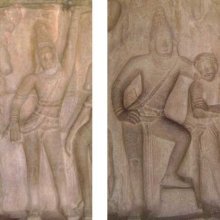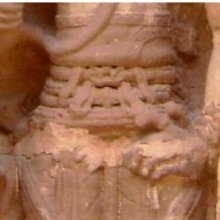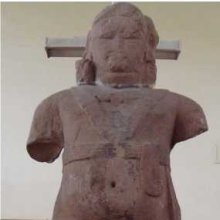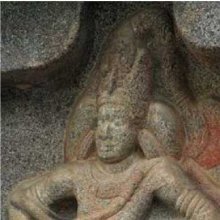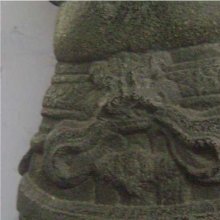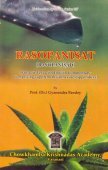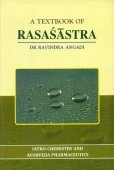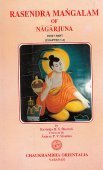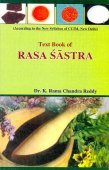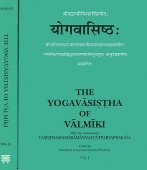Bandha, Bamdha: 40 definitions
Introduction:
Bandha means something in Buddhism, Pali, Hinduism, Sanskrit, Jainism, Prakrit, the history of ancient India, Marathi. If you want to know the exact meaning, history, etymology or English translation of this term then check out the descriptions on this page. Add your comment or reference to a book if you want to contribute to this summary article.
Images (photo gallery)
In Hinduism
Yoga (school of philosophy)
Source: WikiPedia: YogaBandha (bond, arrest) is a term for the “body locks” in Hatha Yoga, treated under the heading of mudra. Specific bandhas are:
- mula-bandha, contraction of the perineum
- uddiyana-bandha, contraction of the abdomen into the rib cage
- jalandhara-bandha, tucking the chin close to the chest
- maha-bandha, combining all three of the above bandhas

Yoga is originally considered a branch of Hindu philosophy (astika), but both ancient and modern Yoga combine the physical, mental and spiritual. Yoga teaches various physical techniques also known as āsanas (postures), used for various purposes (eg., meditation, contemplation, relaxation).
Ayurveda (science of life)
Rasashastra (Alchemy and Herbo-Mineral preparations)
Source: Google Books: The Alchemical BodyBandha (बन्ध):—There are three principel bandhas (“locks” or “contractions”), according the haṭhayoga, which, affected at the levels of the abdomen, thorax, and head, work hydraulically to effect internal changes in pressure, such that breath and seed become immobilized or begin to be drawn upward.
These are the:
- mūla-bandha,
-
uḍḍiyāna-bandha
- and jālandhara-bandha.
The conjoined aim of the three bandhas is to gradually restrict the field in which the volatile breath, seed, and mind may move. First forcing them up out of the abdomen, they “lock” them into the torso; they next “contract” them inside the neck and head; and lastly, they “bind” them there.
Unclassified Ayurveda definitions
Source: gurumukhi.ru: Ayurveda glossary of terms1) Bandha (बन्ध):—Suppressed
2) One of the action attributed to jala mahabhuta

Āyurveda (आयुर्वेद, ayurveda) is a branch of Indian science dealing with medicine, herbalism, taxology, anatomy, surgery, alchemy and related topics. Traditional practice of Āyurveda in ancient India dates back to at least the first millenium BC. Literature is commonly written in Sanskrit using various poetic metres.
Dharmashastra (religious law)
Source: Wisdom Library: Dharma-śāstraBandha (बन्ध) is a Sanskrit technical term, used in jurisdiction, referring to “penalty”. It is placed after a numeral word and stands for the ‘tenth part’. The word is used throughout Dharmaśāstra literature such as the Manusmṛti. (See the Manubhāṣya 8.107)

Dharmashastra (धर्मशास्त्र, dharmaśāstra) contains the instructions (shastra) regarding religious conduct of livelihood (dharma), ceremonies, jurisprudence (study of law) and more. It is categorized as smriti, an important and authoritative selection of books dealing with the Hindu lifestyle.
Purana and Itihasa (epic history)
Source: archive.org: Shiva Purana - English Translation1) Bandha (बन्ध) (Cf. Bandhana) refers to “bondage”, as defined in the Śivapurāṇa 1.18. Accordingly, “a Jīva is said to be in bondage (bandha) if he is tied up by the noose of eight-fold primary essences, Prakṛti etc. When freed from them he is called liberated (mukta). Perfect control and subjugation of Prakṛti and its offshoots is Salvation. A Jīva in bondage when freed from it is called a liberated soul (muktajīva). The set of eight that binds is:—Prakṛti, Buddhi (cosmic intellect), Ahaṃkāra (cosmic ego) of the nature of attributes, and the five Tanmātrās (cosmic principles of Ether etc.) The body is evolved out of these eight. The body carries on activities. The activities generate the body. Thus birth and activities continue in a series”.
2) Bandha (बन्ध) refers to a “prisoner”, according to the Śivapurāṇa 2.3.24 (“Śiva consents to marry Pārvatī”).—Accordingly, as Śiva said to Viṣṇu: “[...] The vow of the king of Assam (Kāmarūpa) was made fruitful. I saved king Sudakṣiṇā who had become a hireling and a prisoner [i.e., bhaima-bandha-gata]. I am the three-eyed God who bestows happiness but brought about the misery of Gautama. I especially curse those wicked persons who harass my devotees. I have the feelings of endearment towards devotees. I drank up poison for the welfare of the gods. O gods, the miseries of the gods have always been removed by me. [...]”.
3) Bandha (बन्ध) refers to the “fittings” (of a chariot), according to the Śivapurāṇa 2.5.8 (“The detailed description of the chariot etc.”).—Accordingly, as Sanatkumāra narrated to Vyāsa: “The divine chariot of lord Śiva consisting of all the worlds was built by Viśvakarman with devoted effort. [...] The forceful and excellent mantras with their syllables and feet, of all characteristic features and the stages in life constituted the tinkling bells. Ananta embellished with thousand hoods constituted its fittings (bandha) [atho bandho hyanantastu sahasraphaṇabhūṣitaḥ], and the main and subsidiary quarters, the pedestals of the chariot. [...]”
Source: Cologne Digital Sanskrit Dictionaries: The Purana Index1a) Bandha (बन्ध).—The place of Budha in the maṇḍalam.*
- * Vāyu-purāṇa 53. 74.
1b) Three, prākṛta, vaikārika and dakṣiṇa, which have their origin in ignorance.*
- * Vāyu-purāṇa 102. 59, 60.

The Purana (पुराण, purāṇas) refers to Sanskrit literature preserving ancient India’s vast cultural history, including historical legends, religious ceremonies, various arts and sciences. The eighteen mahapuranas total over 400,000 shlokas (metrical couplets) and date to at least several centuries BCE.
Shilpashastra (iconography)
Source: Shodhganga: Vaisnava Agamas And Visnu ImagesBandha (बन्ध) refers to “decorative bands”, as defined in treatises such as the Pāñcarātra, Pādmasaṃhitā and Vaikhānasa-āgamas, extensively dealing with the technical features of temple art, iconography and architecture in Vaishnavism.—The Āgamas and Śilpa-works pay more attention to several type of bands or bandhas (kūcabandha, stanabandha, kaṭibandha, udarabandha), threads or sūtras (including the sacred cord yajñasūtra, kaṭisūtra, urassūtra/ plambasūtra etc.), girdles, strings and belts which adorn the torso (like the channavīra cross-belt), the waist and hip (mekhalā, ūrudāma, kañcīdāma etc.) down to the thighs. According to Bharata, variety of garlands set with jewels and made with artistic perfection are the ornaments of chest and jewelled strings are embellishment for the breast.

Shilpashastra (शिल्पशास्त्र, śilpaśāstra) represents the ancient Indian science (shastra) of creative arts (shilpa) such as sculpture, iconography and painting. Closely related to Vastushastra (architecture), they often share the same literature.
Vastushastra (architecture)
Source: OpenEdition books: Architectural terms contained in Ajitāgama and RauravāgamaBandha (बन्ध) [or bandhana] refers to “mortar §§ 2.11, 16.”.—(For paragraphs cf. Les enseignements architecturaux de l'Ajitāgama et du Rauravāgama by Bruno Dagens)

Vastushastra (वास्तुशास्त्र, vāstuśāstra) refers to the ancient Indian science (shastra) of architecture (vastu), dealing with topics such architecture, sculpture, town-building, fort building and various other constructions. Vastu also deals with the philosophy of the architectural relation with the cosmic universe.
Shaktism (Shakta philosophy)
Source: Google Books: ManthanabhairavatantramBandha (बन्ध) [=Bandhana?] or Janmabandha refers to the “bondage (of birth)”, according to the Manthānabhairavatantra, a vast sprawling work that belongs to a corpus of Tantric texts concerned with the worship of the goddess Kubjikā.—Accordingly, “[...] Practice Yoga [i.e., yogābhyāsa] in the sphere of the Supreme Syllable. The thread (sūtra) of the Supreme Syllable is the heart that fulfils all desires. He who, established in the venerable (goddess) Kujā, knows (this) is liberated from the bondage of birth [i.e., janma-bandhana]. (Perfect) contemplation (samādhi) is with (these) sixteen aspects and is (attained) within the form of the sixfold deposition (ṣoḍhānyāsa). He who knows this is (a veritable) Lord of Yogis, the others (who do not) are (just) quoting from books. Once attained the plane that is Void and Non-void, the yogi is freed from bondage”.

Shakta (शाक्त, śākta) or Shaktism (śāktism) represents a tradition of Hinduism where the Goddess (Devi) is revered and worshipped. Shakta literature includes a range of scriptures, including various Agamas and Tantras, although its roots may be traced back to the Vedas.
Jyotisha (astronomy and astrology)
Source: Wisdom Library: Brihat Samhita by VarahamihiraBandha (बन्ध) refers to “torturing”, according to the Bṛhatsaṃhitā (chapter 15) (“On the nakṣatras—‘asterisms’”), an encyclopedic Sanskrit work written by Varāhamihira mainly focusing on the science of ancient Indian astronomy astronomy (Jyotiṣa).—Accordingly, “[...] Those who are born on the lunar day of Mṛgaśirṣa will delight or deal in perfumes, dress, pearls, flowers, fruits, precious stones, wild beasts, birds and deer; will be Somayajis or singers; will be lascivious; will be good writers or painters. Those who are born on the lunar day of Ārdrā will delight in killing, torturing (bandha), lying, in adultery, thieving, cheating and tale-bearing; will deal in pod-grains, black magic, sorcery and exorcism. [...]”.

Jyotisha (ज्योतिष, jyotiṣa or jyotish) refers to ‘astronomy’ or “Vedic astrology” and represents the fifth of the six Vedangas (additional sciences to be studied along with the Vedas). Jyotisha concerns itself with the study and prediction of the movements of celestial bodies, in order to calculate the auspicious time for rituals and ceremonies.
Shaivism (Shaiva philosophy)
Source: SOAS University of London: Protective Rites in the Netra Tantra1) Bandha (बन्ध) refers to the “bound” (condition of living beings), according to the Netratantra of Kṣemarāja: a Śaiva text from the 9th century in which Śiva (Bhairava) teaches Pārvatī topics such as metaphysics, cosmology, and soteriology.—Accordingly, [verse 21.2-5]—“[...] An action of [one who is] bodiless cannot be seen, O Parameśvara. When having a body [results in a condition] in all living beings of [being] bound (bandha), how does the agency of the bound [individual] contradict those agents [who are] devoid of power? Thus, [because] mantras consist of the nature of Śiva, how do they actually accomplish [anything]?”.
2) Bandha (बन्ध) refers to “captivity” (in dreams), according to the Svacchanda-tantra.—Accordingly, [verse 4.21-27, while describing inauspicious dreams]—“[...] [He] who sees black and red garments or an altered self [has inauspicious dreams]. In dreams [he] laughs and dances while [he] wears faded garlands, cuts up one’s own flesh. [He dreams of] captivity (bandha), being eaten by a black snake, and [dreams of] a wedding. [If he] sees this in dreams, he is not successful”.

Shaiva (शैव, śaiva) or Shaivism (śaivism) represents a tradition of Hinduism worshiping Shiva as the supreme being. Closely related to Shaktism, Shaiva literature includes a range of scriptures, including Tantras, while the root of this tradition may be traced back to the ancient Vedas.
Sports, Arts and Entertainment (wordly enjoyments)
Source: archive.org: Syainika Sastra of Rudradeva with English Translation (art)1) Bandha (बन्ध) refers to “bondage” (of one’s addiction to vices), according to the Śyainika-śāstra: a Sanskrit treatise dealing with the divisions and benefits of Hunting and Hawking, written by Rājā Rudradeva (or Candradeva) in possibly the 13th century.—Accordingly, “[...] Among these [sports], eighteen things are mentioned which are known as vyasana (addictions or vices), and without these the senses are useless, and these eighteen are the real causes of exquisite delight. [...] The conclusion, therefore, is that addiction to these vices is to be avoided by all means, because the Lord has said that addiction to these leads to bondage (bandha). [...]”.
2) Bandha (बन्ध) refers “tying (the wings)” (of the hawk) (as part of its training), according to the Śyainika-śāstra.—Accordingly, [while discussing the training of hawks]: “In calling the hawk, either its wings should be tied (pakṣa-bandha) or it should be covered with cloth. When it comes it should be rewarded by food, so that it may not be disappointed. [...] If highly fed, they grow naughty ; if starved, they do not grow attached or strong. Birds of this clas are like low people. [...]”.

This section covers the skills and profiencies of the Kalas (“performing arts”) and Shastras (“sciences”) involving ancient Indian traditions of sports, games, arts, entertainment, love-making and other means of wordly enjoyments. Traditionally these topics were dealt with in Sanskrit treatises explaing the philosophy and the justification of enjoying the pleasures of the senses.
In Buddhism
Mahayana (major branch of Buddhism)
Source: De Gruyter: A Buddhist Ritual Manual on Agriculture1) Bandha (बन्ध) refers to the “tying (of a knot)” (in one’s robe), according to the 2nd-century Meghasūtra (“Cloud Sutra”) in those passages which contain ritual instructions.—Accordingly, “In the end of one’s robe a knot must be tied (granthi-bandha) with seven prayers by the prophet of the Law after he has previously made provision for his safety. This ‘Whirlwind’-Chapter, (also) called “The heart of all Serpents,” must be recited. [...]”
2) Bandha (बन्ध) refers to a “sealing (of the boundaries)” (for all Nāgas), according to the Vajratuṇḍasamayakalparāja, an ancient Buddhist ritual manual on agriculture from the 5th-century (or earlier), containing various instructions for the Sangha to provide agriculture-related services to laypeople including rain-making, weather control and crop protection.—Accordingly, [As the Bhagavān gives instructions for protection of crops]: “[...] They will be well protected. There will be a sealing of the boundaries (sīmā-bandha) for all Nāgas: the slopes of the great fire-mountain will completely cover the four directions and the great fire blaze mass cloud that is the expanded [wings] of the Garuḍa speed bird, called a great mass, will cover the sky. It is there for the protection of all flowers and fruits. All Nāgas and so on will be burnt by that. All harmful Nāgas will be destroyed”.

Mahayana (महायान, mahāyāna) is a major branch of Buddhism focusing on the path of a Bodhisattva (spiritual aspirants/ enlightened beings). Extant literature is vast and primarely composed in the Sanskrit language. There are many sūtras of which some of the earliest are the various Prajñāpāramitā sūtras.
In Jainism
Jain philosophy
Source: archive.org: Anekanta Jaya Pataka of Haribhadra SuriBandha (बन्ध) refers to “bondage”, as occurring in the Anekāntajayapatākā-prakaraṇa, a Śvetāmbara Jain philosophical work written by Haribhadra Sūri.—[Cf. Vol. I, P. 398, l. 26]
-
General definition (in Jainism)
Source: archive.org: Jaina YogaBandha (बन्ध) refers to one of the transgressions (aticāra) of the Ahiṃsā-vrata (vow of non-violence).—Bandha according to Haribhadra (commentary on the Āvaśyaka-sūtra) applies to the tying up or keeping in captivity of men or beasts. Siddhasena Gaṇin (commentary on the Tattvārtha-sūtra) stresses that bandha is very often utterly wanton as when ants, or other insects, are tied for amusement. It may, however, be quite legitimate when an unruly child, or slave, or servant has to be corrected or when horses, cattle, buffaloes, or elephants are kept for domestic use. The general view seems to be that such action—and this applies to the other contraventions of this vrata—ranks as an aticāra when done in anger.
Source: archive.org: TrisastisalakapurusacaritraBandha (बन्ध) refers to “bondage” and represents one of the seven tattvas (principles), according to chapter 4.4 [anantanātha-caritra] of Hemacandra’s 11th century Triṣaṣṭiśalākāpuruṣacaritra: an ancient Sanskrit epic poem narrating the history and legends of sixty-three illustrious persons in Jainism.
Accordingly, as Anantanātha said:—“[...] When a soul takes matter suitable for karma, because of the state of passions, that is bondage (bandha), the cause of absence of free will on the part of the soul. Its divisions are nature, duration, intensity, and quantity. Nature (prakṛti) is inherently eight-fold, knowledge-obscuring, etc. Knowledge- and belief-obscuring, feeling, deluding, age, body-making, family, and obstructive are considered the primary kinds of nature. Duration (sthiti) is the minimum and maximum time limit of karmas. Intensity (anubhāva) is the maturity; quantity (pradeśa) is the allotment of parts. Wrong belief, lack of self-control, negligence, anger, etc. (the kaṣāyas), and activity—these five are recognized as sources of bondage (bandha). [...]”.
Source: Atma Dharma: Principles of JainismBondage; That particular relationship (between two or more than two substances) which conveys the knowledge of oneness in many (separate) things is called bondage (bandha).
Source: Encyclopedia of Jainism: Tattvartha SutraBandha (बन्ध, “bondage”) according to the Tattvārthasūtra 1.4, “the soul, the non-soul, influx, bondage (bandha), stoppage, gradual dissociation and liberation constitute reality (tattva)”.—What is meant by bondage (bandha)? Getting together of space-points of soul with karma particles is called bondage.
Source: Encyclopedia of Jainism: Tattvartha Sutra 5: The category of the non-livingBandha (बन्ध, “union”) refers to one of the forms of matter according to the 2nd-century Tattvārthasūtra 5.24.—How many types of union (bandha) are there? There are two types of union namely contrived (prāyogika) and natural (vaistrasika). What is natural (vaisrasika) union? The union caused without the involvement/effort of living beings is called natural union. What is the characteristic of contrived (prāyogika) union? Necessity of human effort is the characteristic of contrived union.
According to Tattvārthasūtra 5.33, combination (bandha) of sub-atoms (paramāṇu) takes place by virtue of smoothness (snigdha) and dryness (rough) (rūkṣatva) properties associated with them. What causes union /combinations? The two attributes of matter namely oily and roughness are the causes of unison /bondage. What is meant by union (bandha)? Combining of two oily and dry sub-atoms together is called union.
Source: Encyclopedia of Jainism: Tattvartha Sutra 7: The Five VowsBandha (बन्ध, “binding”) refers to one of the five transgressions (aticara) of the “minor vow of non-violence” (ahiṃsā-aṇuvrata) according to the 2nd-century Tattvārthasūtra 7.25.—What is meant by binding (bandha)? To fasten a living being with cord or chain or to keep in a cage or cell as to prevent their free movement is called binding.
Source: Encyclopedia of Jainism: Tattvartha Sutra 8: Bondage of karmasBandha (बन्ध, “bondage”) refers to the “bonding of the matter particles fit to be karmas with the soul (in the state of passions)” according to the 2nd-century Tattvārthasūtra 8.2.—Whenever the empirical soul is tainted with passion and gets involved in activities, it creates vibrations in the surroundings filled with matter particles capable of becoming karma. These matter particles then get attracted towards the soul and get bonded like red hot iron when dipped in water attracts water from all sides. How are the new karmas bonded with the soul (bandha)? Bondage of the empirical soul with karmas exists from beginning-less time. When the existing (already bonded) karmas rise they cause passions in the soul’s disposition which if not checked by the soul cause new bondage of karmas.
Also, “The five causes of bondage are wrong belief (mithyādarśana), non-abstinence (avirati), negligence (pramāda), passions (kaṣāya) and activities (yoga)”.
According to verse 8.3, “bondage (bandha) is of four kinds namely species (prakṛti), duration (sthiti), potency (anubhāga) and quantity of space-points (pradeśa). What are the causes of these four types of bondage (bandha)? The species and space-points bondage are caused by activities while the potency and duration bondage is caused by passions. Which influx type has all four kinds of bondage (bandha)? Influx towards soul tainted with passion (sāmparāyika) has all kinds of bondage. Till which stage of spiritual purification all four kinds of bondage (bandha) are possible? Till the tenth stage of spiritual purification, all four kinds of bondage can take place”.
Source: HereNow4u: Jain Dharma ka Maulika Itihasa (2)Bandha (बन्ध) refers to “bondage” and is one of the topics treated in the Sūtrakṛtāṅga (Sūtrakṛtāṃga), one of the Dvādaśāṅgī (twelve Aṅgas) of Jainism.—Sūtrakṛtāṅga is the second Āgama of the Dvādaśāṅgī. Sūtra kṛatāṃga has 2 Śruta skaṇdhas. The first Śruta skaṇdha has 16 and the second has 7 lectures; in all 23 chapters, 33 topics, 33 sub topics and 36000 verses. Topics include dissociation of bondage (bandha).
Source: The University of Sydney: A study of the Twelve ReflectionsBandha (बन्ध) refers to the “binding of karma” and represents one of the seven reals (tattvas), according to the 11th century Jñānārṇava, a treatise on Jain Yoga in roughly 2200 Sanskrit verses composed by Śubhacandra.—Accordingly, “Consequently, the sages have said that the seven reals are sentient soul, non-sentient matter, the influx of karma, the binding of karma (bandha), stopping the influx of karma, wearing away karma and liberation”.

Jainism is an Indian religion of Dharma whose doctrine revolves around harmlessness (ahimsa) towards every living being. The two major branches (Digambara and Svetambara) of Jainism stimulate self-control (or, shramana, ‘self-reliance’) and spiritual development through a path of peace for the soul to progess to the ultimate goal.
India history and geography
Source: Cologne Digital Sanskrit Dictionaries: Indian Epigraphical GlossaryBandha.—(EI 31), a dam or highway. Note: bandha is defined in the “Indian epigraphical glossary” as it can be found on ancient inscriptions commonly written in Sanskrit, Prakrit or Dravidian languages.

The history of India traces the identification of countries, villages, towns and other regions of India, as well as mythology, zoology, royal dynasties, rulers, tribes, local festivities and traditions and regional languages. Ancient India enjoyed religious freedom and encourages the path of Dharma, a concept common to Buddhism, Hinduism, and Jainism.
Languages of India and abroad
Pali-English dictionary
Source: BuddhaSasana: Concise Pali-English Dictionarybandha : (m.) bound; fetter; attachment; imprisonment.
Source: Sutta: The Pali Text Society's Pali-English DictionaryBandha, (adj.) (cp. Vedic bandha, fr. bandh) 1. bond, fetter It. 56 (abandho Mārassa, not a victim of M.); Nd1 328 (taṇhā°, diṭṭhi°); ThA. 241.—2. one who binds or ties together, in assa° horsekeeper, groom J. II, 98; V, 441, 449; DhA. I, 392.—3. a sort of binding: maṇḍala° with a circular b. (parasol) Vin. IV, 338, salāka° with a notched b. ibid.—4. a halter, tether Dpvs. I, 76.—Cp. vinibandha. (Page 481)

Pali is the language of the Tipiṭaka, which is the sacred canon of Theravāda Buddhism and contains much of the Buddha’s speech. Closeley related to Sanskrit, both languages are used interchangeably between religions.
Marathi-English dictionary
Source: DDSA: The Molesworth Marathi and English Dictionarybandha (बंध).—m (S) A regulation, law, rule, bond; a restriction or restraint in general. 2 Restriction, limitation, confinement. 3 A mode of writing stanzas &c.--disposing of the letters, according to a certain order, in the cells or compartments of a particular figure. 4 A piece of string, tape &c., anything to tie with: also any tie or fastening; and fig. a bond, fetter, shackle, let, hinderance. In this sense used also in comp. as mōhabandha, āśābandha, māyābandha, bhavabandha. See other compounds under the more commonly employed words jāla & pāśa.
--- OR ---
bāndha (बांध).—m A dam, embankment, dyke. v ghāla. 2 The raised boundary (of a field): also, sometimes, a passage through or along the margin. 3 Tying, fastening, binding. 4 (Better banda) A piece of string, tape &c., anything to tie with: also any tie or fastening; and fig. a bond or fetter.
--- OR ---
bāndhā (बांधा).—m (bāndhaṇēṃ) Make, structure, compacture, shape, form.
--- OR ---
bāndhā (बांधा).—a (Better bandā) Whole, unchanged into smaller coin--a rupee &c. 2 fig. Determined or defined--service, duties, wages.
Source: DDSA: The Aryabhusan school dictionary, Marathi-Englishbandha (बंध).—m A regulation. Restriction. A mode of writing stanzas. Tie. A bond, fetter.
--- OR ---
bāndha (बांध).—m A dam, dyke, Binding. A bond. f Any tie or fasting.
--- OR ---
bāndhā (बांधा).—m Make; form. a See bandā.
Marathi is an Indo-European language having over 70 million native speakers people in (predominantly) Maharashtra India. Marathi, like many other Indo-Aryan languages, evolved from early forms of Prakrit, which itself is a subset of Sanskrit, one of the most ancient languages of the world.
Sanskrit dictionary
Source: DDSA: The practical Sanskrit-English dictionaryBandha (बन्ध).—[bandh-ghañ]
1) A tie, bond (in general) (āśābandha &c.).
2) A hair-band, fillet; रतिविगलितबन्धे केशहस्ते सुकेश्याः (rativigalitabandhe keśahaste sukeśyāḥ) (sati) V.4.22; Ś.1.29.
3) A chain, fetter.
4) Fettering, confining, imprisoning, confinement, imprisonment; बन्धं चानिच्छता घोरं त्वयासौ पुरुषर्षभ (bandhaṃ cānicchatā ghoraṃ tvayāsau puruṣarṣabha) Rām.5. 21.19; अधार्मिकं त्रिभिर्न्यायैर्निगृह्णीयात् प्रयत्नतः । निरोधनेन बन्धेन विविधेन वधेन च (adhārmikaṃ tribhirnyāyairnigṛhṇīyāt prayatnataḥ | nirodhanena bandhena vividhena vadhena ca) || Manusmṛti 8.31.
5) Catching, capturing, catching hold of; गजबन्ध (gajabandha) R.16.2.
6) (a) Forming, constructing, arranging; सर्गबन्धो महाकाव्यम् (sargabandho mahākāvyam) S. D.6. (b) Building, erecting.
7) Feeling, conceiving, cherishing; हे राजानस्त्यजत सुकविप्रेमबन्धे विरोधम् (he rājānastyajata sukavipremabandhe virodham) Vikr.18.17; R.6.81.
8) Connection, union, intercourse.
9) Joining or folding together, combining; प्रासादवातायनदृश्यबन्धैः साकेतनार्योऽ- ञ्जलिभिः प्रणेमुः (prāsādavātāyanadṛśyabandhaiḥ sāketanāryo'- ñjalibhiḥ praṇemuḥ) R.14.13; अञ्जलिबन्धः (añjalibandhaḥ) &c.
1) A bandage, ligature.
11) Agreement, harmony.
12) Manifestation, display, exhibition; मनसिजतरुपुष्पं रागबन्धप्रवालम् (manasijatarupuṣpaṃ rāgabandhapravālam) (yauvanam) R.18.52.
13) Bondage, confinement to this world (opp. mukti which is 'complete emancipation from the trammels of the world'); बन्धं मोक्षं च या वेत्ति बुद्धिः सा पार्थ सात्त्विकी (bandhaṃ mokṣaṃ ca yā vetti buddhiḥ sā pārtha sāttvikī) Bhagavadgītā (Bombay) 18.3; बन्धोन्मुक्त्यै खलु मखमुखान् कुर्वते कर्मपाशान् (bandhonmuktyai khalu makhamukhān kurvate karmapāśān) Bv.4.21; R.13.58;18.7.
14) Result, consequence.
15) A position, posture in general; आसनबन्धधीरः (āsanabandhadhīraḥ) R.2. 6; पर्यङ्कबन्धस्थिरपूर्वकायम् (paryaṅkabandhasthirapūrvakāyam) Kumārasambhava 3.45,59.
16) A particular position in sexual intercourse, or a particular mode of sexual enjoyment (these are said in Ratimañjarī to be 16, but other writers increase the number to 84).
17) A border, frame-work.
18) Arrangement of a stanza in a particular shape; e. g. खड्गबन्ध, पद्मबन्ध, मुरजबन्ध (khaḍgabandha, padmabandha, murajabandha) (vide K. P.9. ad loc.).
19) A sinew, tendon.
2) The body.
21) A deposit, pledge.
22) An embankment, throwing a bridge across (a river).
23) A disease in which the eyelids cannot be wholly closed.
Derivable forms: bandhaḥ (बन्धः).
Source: Cologne Digital Sanskrit Dictionaries: Shabda-Sagara Sanskrit-English DictionaryBandha (बन्ध).—m.
(-ndhaḥ) 1. A pledge, a deposit. 2. A binding, a tie or fetter, &c. 3. Binding, tying. 4. The body. 5. Joining. 6. Forming. 7. A ligature, a bandage. 8. Connection, intercourse. 9. Agreement, union. 10. Result. 11. Border, frame-work. 12. The body. 13. Manifestation, display. 14. Bondage, (opposite to annihilation.) 15. A posture. 16. The different forms of sexual intercourse mentioned in Kama Shastra. 17. Feeling. 18. Laying snares. 19. A stanza which can be arranged in a particular shape, as “Padma bandha,” &c. E. bandh to tie, aff. ac .
Source: Cologne Digital Sanskrit Dictionaries: Benfey Sanskrit-English DictionaryBandha (बन्ध).—[bandh + a], m. 1. Binding. [Pañcatantra] 248, 12; laying (snares), [Pañcatantra] 114, 11. 2. Holding in fetters, [Mānavadharmaśāstra] 8, 310. 3. The body. 4. Building, [Rājataraṅgiṇī] 5, 114. 5. Forming, 344. 6. Agreement, [Daśakumāracarita] in
Bandha (बन्ध).—[masculine] binding, tying to ([especially] the sacrificial post), fettering, capturing; custody, prison; band, string, sinew (of the body); chain, tether, bondage ([opposed] mukti); joining together, connection, position ([especially] of hands, feet, etc.); union, intercourse with (—°); forming, constructing; embankment, covering with a bridge; fixing or turning upon ([locative]); manifestation, exhibition, show, display (—°).
Source: Cologne Digital Sanskrit Dictionaries: Monier-Williams Sanskrit-English Dictionary1) Bandha (बन्ध):—[from bandh] m. binding, tying, a bond, tie, chain, fetter, [Ṛg-veda] etc. etc.
2) [v.s. ...] a ligature, bandage, [Suśruta]
3) [v.s. ...] damming up (a river), [Mārkaṇḍeya-purāṇa]
4) [v.s. ...] capture, arrest, imprisonment, custody, [Manu-smṛti; Mahābhārata] etc.
5) [v.s. ...] connection or intercourse with ([compound]), [Pañcatantra; Bhāgavata-purāṇa] (ifc. = connected with, conducive to, [Mahābhārata])
6) [v.s. ...] putting together, uniting, contracting, combining, forming, producing, [Mahābhārata; Kāvya literature] etc.
7) [v.s. ...] joining (the hollowed hands), [Raghuvaṃśa]
8) [v.s. ...] anything deposited (dhe-√sthā = to remain deposited), [Campaka-śreṣṭhi-kathānaka]
9) [v.s. ...] a deposit, pledge, [Rājataraṅgiṇī]
10) [v.s. ...] any configuration or position of the body ([especially] of the hands and feet), [Raghuvaṃśa; Kumāra-sambhava]
11) [v.s. ...] a [particular] mode of sexual union (there are said to be 16, 18, 36, or even 84 [cf. Lexicographers, esp. such as amarasiṃha, halāyudha, hemacandra, etc.]), [Caur.]
12) [v.s. ...] constructing, building (of a bridge etc.), [Mahābhārata; Rājataraṅgiṇī]
13) [v.s. ...] bridging over (the sea), [Vikramāṅkadeva-carita, by Bilhaṇa]
14) [v.s. ...] knitting (the brows), [Rājataraṅgiṇī]
15) [v.s. ...] fixing, directing (mind, eyes, etc.), [Catalogue(s)]
16) [v.s. ...] assumption, obtainment (of a body), [Raghuvaṃśa]
17) [v.s. ...] (ifc.) conceiving, cherishing, feeling, betraying, [Harivaṃśa; Kālidāsa]
18) [v.s. ...] a border, framework, inclosure, receptacle, [cf. Lexicographers, esp. such as amarasiṃha, halāyudha, hemacandra, etc.]
19) [v.s. ...] a sinew, tendon, [cf. Lexicographers, esp. such as amarasiṃha, halāyudha, hemacandra, etc.]
20) [v.s. ...] the body, [cf. Lexicographers, esp. such as amarasiṃha, halāyudha, hemacandra, etc.]
21) [v.s. ...] (in [philosophy]) mundane bondage, attachment to this world, [Śvetāśvatara-upaniṣad; Bhagavad-gītā] etc. (opp. to mukti, mokṣa, ‘final emancipation’, and regarded in the Sāṃkhya as threefold, viz. prakṛti-, vaikārika-, and dakṣiṇā-b)
22) [v.s. ...] combination of sounds (in [rhetoric]), construction or arrangement of words, [Kāvyādarśa; Pratāparudrīya]
23) [v.s. ...] arrangement of a stanza in a [particular] shape, [Kāvyaprakāśa]
24) [v.s. ...] arrangement of musical sounds, composition, [Śatruṃjaya-māhātmya]
25) [v.s. ...] a disease which prevents the eyelids from quite closing, [Suśruta]
26) [v.s. ...] (ifc. with numerals) a part (cf. pañca-, daśa-b).
Source: Cologne Digital Sanskrit Dictionaries: Yates Sanskrit-English DictionaryBandha (बन्ध):—(ndhaḥ) 1. m. A pledge, a deposite; a binding; the body.
Source: DDSA: Paia-sadda-mahannavo; a comprehensive Prakrit Hindi dictionary (S)Bandha (बन्ध) in the Sanskrit language is related to the Prakrit words: Baṃdha, Bajjha.
[Sanskrit to German]
Sanskrit, also spelled संस्कृतम् (saṃskṛtam), is an ancient language of India commonly seen as the grandmother of the Indo-European language family (even English!). Closely allied with Prakrit and Pali, Sanskrit is more exhaustive in both grammar and terms and has the most extensive collection of literature in the world, greatly surpassing its sister-languages Greek and Latin.
Prakrit-English dictionary
Source: DDSA: Paia-sadda-mahannavo; a comprehensive Prakrit Hindi dictionary1) Baṃdha (बंध) in the Prakrit language is related to the Sanskrit word: Bandh.
2) Baṃdha (बंध) also relates to the Sanskrit word: Bandha.
Prakrit is an ancient language closely associated with both Pali and Sanskrit. Jain literature is often composed in this language or sub-dialects, such as the Agamas and their commentaries which are written in Ardhamagadhi and Maharashtri Prakrit. The earliest extant texts can be dated to as early as the 4th century BCE although core portions might be older.
Kannada-English dictionary
Source: Alar: Kannada-English corpusBaṃdha (ಬಂಧ):—
1) [noun] the state of being bound, tied or fastened.
2) [noun] a rope or cord (used to to bind something).
3) [noun] handcuffs or shackles.
4) [noun] a strip of cloth or other material used to bind up a wound, sore, sprain, etc.; bandage.
5) [noun] a depositing of an article for the payment of debt or fulfilment of a promise; pledging.
6) [noun] the act of arresting or imprisoning.
7) [noun] the act of joining two or more things together.
8) [noun] an instance of this.
9) [noun] that which is united.
10) [noun] that which is solid (as distinguished from being loose and liquid).
11) [noun] a composing of a literary work (as an essay, poetry, etc.).
12) [noun] the district or region that lies along the border.
13) [noun] the plant Breynia rhamonoides of Euphorbiaceae family.
14) [noun] another tree Bridelia hamiltoniana of the same family.
15) [noun] another tree Bridelia montana of the same family.
16) [noun] the tree Diospyros peregrina of Ebenaceae family.
17) [noun] the mundane, worldly attachments.
Kannada is a Dravidian language (as opposed to the Indo-European language family) mainly spoken in the southwestern region of India.
Nepali dictionary
Source: unoes: Nepali-English DictionaryBandha (बन्ध):—n. 1. → बन्धन [bandhana ] ; 2. string; rope; 3. prison; imprisonment; 4. dam; embankment; 5. wall; jail; cell; 6. structural design of a literary work;
Nepali is the primary language of the Nepalese people counting almost 20 million native speakers. The country of Nepal is situated in the Himalaya mountain range to the north of India.
See also (Relevant definitions)
Starts with (+100): Bamdhabamdhi, Bamdhaga, Bamdhai, Bamdhamocana, Bamdhanagolisu, Bamdhanakari, Bamdhanaya, Bamdhavia, Bamdhavida, Bamdhavimocini, Bamdhaya, Bandha-danda, Bandha-kobi, Bandhabandha, Bandhabandholi, Bandhabindu, Bandhaccheda, Bandhachulikukkutasana, Bandhaculikukkutasana, Bandhadesha.
Ends with (+544): Ababamdha, Abandha, Abhavanmatasambandha, Abhisambandha, Abjabandha, Acalanibandha, Acci-bandha, Adharyadharasambandha, Adhibandha, Adhonibandha, Ajitakhyatantratikanibandha, Akramanirbamdha, Akshibandha, Alabandha, Alikabamdha, Alikanirbandha, Amjalibamdha, Amurtasambandha, Anabhisambandha, Anaitikasambamdha.
Full-text (+871): Kubandha, Mahabandha, Vibandha, Bandh, Karibandha, Tapasi, Manibandha, Padabandha, Mushtibandham, Kutabandham, Dehabandha, Viparitaka, Bandhakartri, Bandhamudra, Bandhakarana, Cakrabandham, Samarata, Hasti-bandha, Sadha Bandha, Bandhana.
Relevant text
Search found 114 books and stories containing Bandha, Bamdha, Bāndha, Bāndhā, Baṃdha; (plurals include: Bandhas, Bamdhas, Bāndhas, Bāndhās, Baṃdhas). You can also click to the full overview containing English textual excerpts. Below are direct links for the most relevant articles:
Garga Samhita (English) (by Danavir Goswami)
Verse 1.6.10 < [Chapter 6 - Description of Kaṃsa’s Strength]
Verse 1.4.9 < [Chapter 4 - Description of Questions About the Lord’s Appearance]
Verse 4.19.63 < [Chapter 19 - A Thousand Names of Srī Yamunā]
Jainism and Patanjali Yoga (Comparative Study) (by Deepak bagadia)
Part 3.4 - Nine Elements (4): Bandha (Bondage of karma) < [Chapter 3 - Jain Philosophy and Practice]
Part 3.4 - Jain Metaphysics—The Nine Elements (nava-tattva) < [Chapter 3 - Jain Philosophy and Practice]
Part 3.4 - Nine Elements (3): Asrava (influx of Karmic Pudgala to Atman or Jiva) < [Chapter 3 - Jain Philosophy and Practice]
Shrimad Bhagavad-gita (by Narayana Gosvami)
Verse 18.30 < [Chapter 18 - Mokṣa-yoga (the Yoga of Liberation)]
Verse 2.39 < [Chapter 2 - Sāṅkhya-yoga (Yoga through distinguishing the Soul from the Body)]
Verse 2.51 < [Chapter 2 - Sāṅkhya-yoga (Yoga through distinguishing the Soul from the Body)]
Head-Gears in Hindu Art < [March 1937]
Theatre Architecture in Ancient India < [November-December 1931]
The Philosophy of Riti < [April 1969]
Shishupala-vadha (Study) (by Shila Chakraborty)
Related products
